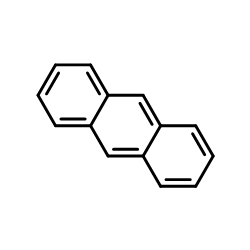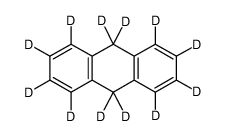1719-06-8
| 中文名 | 蒽-d10 |
|---|---|
| 英文名 | 1,2,3,4,5,6,7,8,9,10-decadeuterioanthracene |
| 中文别名 |
蒽–d10
蒽-D10 |
| 英文别名 |
(H)Anthracene
Anthracene-d EINECS 217-004-5 anthracene-d10 decadeuterio-anthracene MFCD00001241 Perdeuterioanthracene Anthracene. perdeutero |
| 密度 | 1.1±0.1 g/cm3 |
|---|---|
| 沸点 | 337.4±9.0 °C at 760 mmHg |
| 熔点 | 210-215ºC(lit.) |
| 分子式 | C14D10 |
| 分子量 | 188.291 |
| 闪点 | 146.6±12.8 °C |
| 精确质量 | 188.141022 |
| LogP | 4.68 |
| 外观性状 | 米色-黄色粉末 |
| 蒸汽压 | 0.0±0.3 mmHg at 25°C |
| 折射率 | 1.715 |
| 储存条件 | 2-8°C密封储存 |
| 稳定性 | 常温常压下稳定,避免氧化物 光 酸接触 |
| 分子结构 | 1、 摩尔折射率:61.93 2、 摩尔体积(m3/mol):157.6 3、 等张比容(90.2K):414.9 4、 表面张力(dyne/cm):47.9 5、 介电常数(F/m):无可用 6、 极化率(10 -24cm 3):24.55 |
| 计算化学 | 1.疏水参数计算参考值(XlogP):无 2.氢键供体数量:0 3.氢键受体数量:0 4.可旋转化学键数量:0 5.互变异构体数量:无 6.拓扑分子极性表面积0 7.重原子数量:14 8.表面电荷:0 9.复杂度:154 10.同位素原子数量:10 11.确定原子立构中心数量:0 12.不确定原子立构中心数量:0 13.确定化学键立构中心数量:0 14.不确定化学键立构中心数量:0 15.共价键单元数量:1 |
| 更多 | 1. 性状:有强烈刺激性的蓝色荧光的黄色结晶体。 2. 密度(g/mL,25/4℃): 1.25 3. 相对蒸汽密度(g/mL,空气=1):未确定 4. 熔点(ºC):210-215 5. 沸点(ºC,常压):340 6. 沸点(ºC,5.2kPa): 未确定 7. 折射率: 未确定 8. 闪点(ºC): 121.11 9. 比旋光度(º): 未确定 10. 自燃点或引燃温度(ºC): 540 11. 蒸气压(kPa,25ºC): 0.13 12. 饱和蒸气压(kPa,60ºC): 未确定 13. 燃烧热(KJ/mol):未确定 14. 临界温度(ºC): 未确定 15. 临界压力(KPa): 未确定 16. 油水(辛醇/水)分配系数的对数值: 未确定 17. 爆炸上限(%,V/V):未确定 18. 爆炸下限(%,V/V): 未确定 19. 溶解性:溶于乙醇、乙醚、苯、氯仿和二硫化碳。 |
Synonym: Section 2 - COMPOSITION, INFORMATION ON INGREDIENTS
Risk Phrases: None Listed. Section 3 - HAZARDS IDENTIFICATION EMERGENCY OVERVIEW
Hygroscopic (absorbs moisture from the air). Potential Health Effects Eye: May cause eye irritation. Skin: Causes mild skin irritation. Ingestion: The toxicological properties of this substance have not been fully investigated. Inhalation: May cause respiratory tract irritation. The toxicological properties of this substance have not been fully investigated. Chronic: Not available. Section 4 - FIRST AID MEASURES Eyes: Flush eyes with plenty of water for at least 15 minutes, occasionally lifting the upper and lower eyelids. Get medical aid. Skin: Get medical aid. Flush skin with plenty of water for at least 15 minutes while removing contaminated clothing and shoes. Ingestion: Get medical aid. Wash mouth out with water. Inhalation: Remove from exposure and move to fresh air immediately. If not breathing, give artificial respiration. If breathing is difficult, give oxygen. Get medical aid. Notes to Physician: Section 5 - FIRE FIGHTING MEASURES General Information: As in any fire, wear a self-contained breathing apparatus in pressure-demand, MSHA/NIOSH (approved or equivalent), and full protective gear. This material in sufficient quantity and reduced particle size is capable of creating a dust explosion. Extinguishing Media: Use water spray, dry chemical, carbon dioxide, or chemical foam. Section 6 - ACCIDENTAL RELEASE MEASURES General Information: Use proper personal protective equipment as indicated in Section 8. Spills/Leaks: Absorb spill with inert material (e.g. vermiculite, sand or earth), then place in suitable container. Section 7 - HANDLING and STORAGE Handling: Avoid breathing dust, vapor, mist, or gas. Avoid contact with skin and eyes. Storage: Store in a cool, dry place. Store in a tightly closed container. Store under nitrogen. Section 8 - EXPOSURE CONTROLS, PERSONAL PROTECTION Engineering Controls: Use adequate ventilation to keep airborne concentrations low. Exposure Limits CAS# 1719-06-8: Personal Protective Equipment Eyes: Not available. Skin: Wear appropriate protective gloves to prevent skin exposure. Clothing: Wear appropriate protective clothing to prevent skin exposure. Respirators: Follow the OSHA respirator regulations found in 29 CFR 1910.134 or European Standard EN 149. Use a NIOSH/MSHA or European Standard EN 149 approved respirator if exposure limits are exceeded or if irritation or other symptoms are experienced. Section 9 - PHYSICAL AND CHEMICAL PROPERTIES Physical State: Powder Color: beige to slight yellow Odor: Not available. pH: Not available. Vapor Pressure: Not available. Viscosity: Not available. Boiling Point: Not available. Freezing/Melting Point: 218-220 deg Autoignition Temperature: Not available. Flash Point: 121 deg C ( 249.80 deg F) Explosion Limits, lower: Not available. Explosion Limits, upper: Not available. Decomposition Temperature: Solubility in water: Insoluble. Specific Gravity/Density: Molecular Formula: C14D10 Molecular Weight: 188.14 Section 10 - STABILITY AND REACTIVITY Chemical Stability: Stable under normal temperatures and pressures. Conditions to Avoid: Incompatible materials, light. Incompatibilities with Other Materials: Strong oxidizing agents, fluorine, acids (mineral, oxidizing, e.g. chromic acid, hypochlorous acid, nitric acid, sulfuric acid), hypochlorite. Hazardous Decomposition Products: Carbon monoxide, carbon dioxide. Hazardous Polymerization: Will not occur. Section 11 - TOXICOLOGICAL INFORMATION RTECS#: CAS# 1719-06-8 unlisted. LD50/LC50: Not available. Carcinogenicity: Anthracene-d10 - Not listed by ACGIH, IARC, or NTP. Section 12 - ECOLOGICAL INFORMATION Section 13 - DISPOSAL CONSIDERATIONS Dispose of in a manner consistent with federal, state, and local regulations. Section 14 - TRANSPORT INFORMATION IATA No information available. IMO No information available. RID/ADR No information available. Section 15 - REGULATORY INFORMATION European/International Regulations European Labeling in Accordance with EC Directives Hazard Symbols: Not available. Risk Phrases: Safety Phrases: S 24/25 Avoid contact with skin and eyes. WGK (Water Danger/Protection) CAS# 1719-06-8: No information available. Canada None of the chemicals in this product are listed on the DSL/NDSL list. CAS# 1719-06-8 is not listed on Canada's Ingredient Disclosure List. US FEDERAL TSCA CAS# 1719-06-8 is not listed on the TSCA inventory. It is for research and development use only. SECTION 16 - ADDITIONAL INFORMATION N/A |
| 符号 |


GHS07, GHS09 |
|---|---|
| 信号词 | Warning |
| 危害声明 | H315-H319-H335-H410 |
| 警示性声明 | P261-P273-P305 + P351 + P338-P501 |
| 靶器官 | Blood, Central nervous system, Liver |
| 危害码 (欧洲) | Xi: Irritant;N: Dangerous for the environment;T: Toxic; |
| 风险声明 (欧洲) | R36/37/38 |
| 安全声明 (欧洲) | 26-60-61-36/37-24/25-23-53 |
| 危险品运输编码 | UN 3077 9 |
| WGK德国 | 2 |
| 上游产品 1 | |
|---|---|
| 下游产品 1 | |




